Powerbank - solar, ordinary or wireless? How to choose a power bank, which energy bank to buy? Which energy banks are the best?
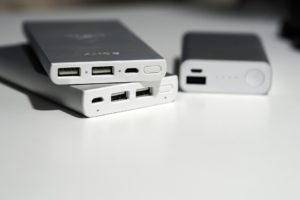 In each journey, sooner or later it will happen that the phone or camera will refuse to work because of the discharged battery. Nasty business. You reach the place that was the object of your travel dreams and ... buuuuu ... the battery kneels. You can't take photos. Man's blood is flooding but you can't do anything. The battery does not forgive. Unless you have a magazine with extra energy somewhere in your pocket, in the form of a shapely powerbank ... then the world will look different. You are not in danger of an energy crisis.
In each journey, sooner or later it will happen that the phone or camera will refuse to work because of the discharged battery. Nasty business. You reach the place that was the object of your travel dreams and ... buuuuu ... the battery kneels. You can't take photos. Man's blood is flooding but you can't do anything. The battery does not forgive. Unless you have a magazine with extra energy somewhere in your pocket, in the form of a shapely powerbank ... then the world will look different. You are not in danger of an energy crisis.
A small device for several dozen zlotys can save beautiful memories of an expedition on which you spent even several thousand. However, there is one condition that the power bank itself will be decent. Because what about you from a power bank, which at a critical moment will turn out to be a sell? After all, it is a device that we reach for in a crisis moment, so we must require 100% certainty of operation from it. This is our last resort! There is no place for questionable quality equipment.
How to choose a power bank?
Before we get to know specific models that you can recommend with a clear conscience, you should realize and understand what device we are looking for. It is clear that the devices that I recommend are not the ones worth buying. These are the ones I know and I chose. There are probably many other interesting solutions on the market that I haven't come across. However, to assess their suitability for your needs yourself, you need to know what to expect from a power bank. So we'll start with a slightly longer technical description, which I will try to present and simplify so that it is understandable to everyone and allows you to consciously choose the device. In addition, the description below will allow you to choose a powerbank suitable for your needs even if the devices change and the models proposed today will no longer be on sale and will be replaced by new ones.
And most importantly, I hope that this description will allow you to avoid buying a device of dubious quality and throwing money away (there are several times more such devices than good ones). Although a loss of several dozen zlotys, compared to the lack of commemorative photos from the trip of dreams, probably the least painful punishment for carelessness.
Parameter no.1 - power bank capacity
This is the most important parameter and you should start with it. I will devote the most space to him. Generally, the more the better, but there are of course limitations. The greater the capacity, the larger the device's dimensions and weight. Nobody will carry a large and heavy battery with them, only to have access to a supply of energy to charge the phone for a month. To determine the energy bank capacity you really need, think about how much energy you need.
What can you charge from the power bank?
Generally, it should be assumed that small and medium-sized portable devices, such as:
- phones and smartphones
- tablets
- digital cameras
- cameras
- car navigation
- smartwatches
- portable game consoles
- mp3 players
- e-book readers
How do you assess the powerbank's capacity you need?
The procedure is simple:
1. Think about what devices you want to charge from the power bank. It is not about all possible devices, but rather those that may require emergency charging during the day.
2. Check the battery capacity of selected devices and add up their capacity. If you don't know the battery capacity of your device, below are approximate values for different types of devices:
- smartphone battery capacity: 3 - 000 mAh
- battery capacity in a compact camera: 1 mAh
- SLR battery capacity: 2 mAh
- tablet battery capacity: 5 - 000 mAh
- video camera battery capacity: 2 - 000 mAh
- battery capacity in the smartwatch: 200 - 500 mAh
- mp3 players, e-book readers and other small portable devices: 1 mAh
3. Multiply the calculated capacity sum by 2. The result of multiplication is the minimum capacity of the power bank you need.
Why do we multiply by 2? Powerbank should guarantee you the ability to charge the devices you need at least once. To this should be taken an additional margin of energy, resulting from several facts:
- it should be assumed that the powerbank may be undercharged for some time and will not be 100% charged. When not used, it slowly discharges spontaneously.
- additionally, it should be remembered that each battery is aging and the battery in a power bank will lose its capacity over time, compared to the capacity it had from the new.
- the charging process takes place with an efficiency of between 80% and 90%. This means that not all the energy taken from the power bank will be transferred to the battery of the device being charged.
Considering the above, and the fact that we want the power bank to serve us for a long time, we multiply the needed capacity by 2.
Example:
1. Choice of devices.
I go on vacation and take: smartphone, compact camera and tablet. During the day I will use the telephone and camera. I won't use the tablet during the day. I will need a tablet in the evenings to browse the Internet, take notes, plan the next days, search for missing information. Then I'll be in the hotel, so I can always connect the tablet to the socket for charging. Powerbank should manage to charge the phone and compact camera.
2. Battery capacity in devices
My phone has a 3 500 mAh battery, and the camera battery has a 1 250 mAh capacity.
Together, this gives you the capacity: 4 750 mAh
3. Powerbank capacity required
2 x 4750 = 9500 mAh
The minimum capacity of the powerbank that meets my needs is 9 500 mAh. In practice, it will be a device with a capacity of 10 000 mAh.
Watch out for buble!
I already know what powerbank capacity I need. What am I doing? I enter the price comparison site in the powerbank category, e.g. Allegro and what do i see
For example:
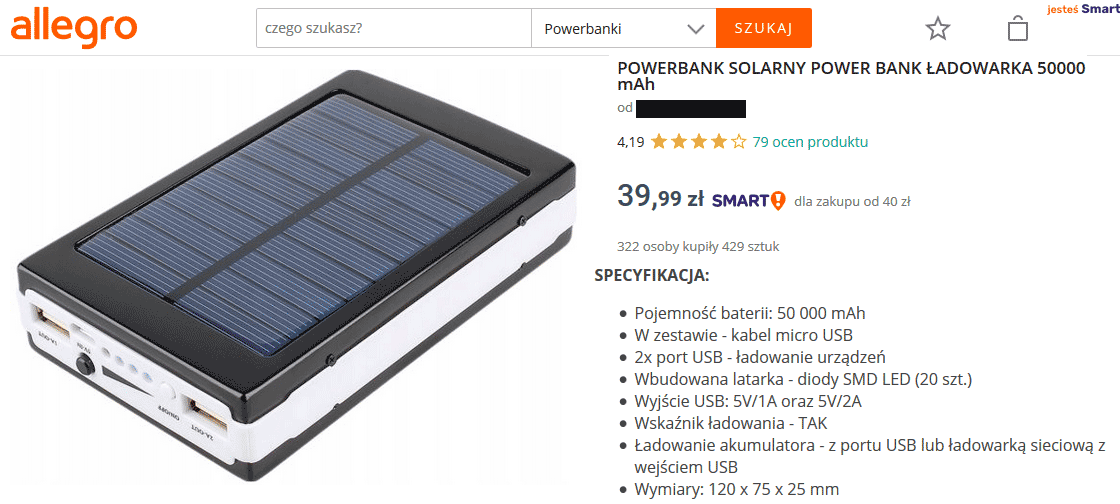
A real technical miracle !!! Shock! 5x Powerbank bigger than the one I need, i.e. 50 000 mAh and solar (charged with light via a solar panel) at a shocking price of PLN 39,99. What are we doing here? This article makes no sense?
Well, ... it's not. He has a deep sleep. This is the sense of this article, so as not to be fooled by such an offer. It's fake and I'm not worth anything. Do not believe in such offers. This is just a scam. It is better to donate this money to any charity than to give money to tricksters.
Of course, you'll get the device as in the picture, but its actual parameters will have nothing to do with the description.
Why is such a power bank a fake?
Here I will provide some information that will allow you to independently verify the credibility of the offers. I think it's worth spending a few moments on this.
Cheap power banks commonly use lithium-ion (li-ion) 18650 cells. The sign looks not very friendly but is very easy to understand. Cells, like batteries, have a cylindrical shape with a certain diameter and length. The numbers in the designation are nothing more than glued together values of the diameter and length of the link. The 18650 link is nothing more than a cylinder having an 18mm diameter and 65mm length (slightly larger than a classic finger battery).
The average, real capacity of a cheap 18650 cell is about 2000 - 2500 mAh. The best and the most expensive, very good 18650 cells achieve real 3500 mAh capacity, but they are not used in cheap power banks, because they are too expensive.
Let's look at the dimensions of the above powerbank.
The thickness is 25mm.
The 18mm diameter cell (+ solar panel and housing thickness) is just right.
Width: 75mm.
The 65mm link (+ connectors on both sides of the link) fits amazingly well.
120mm length.
It houses 5 cells with a diameter of 18mm, which gives 90mm, the rest (30 mm) for USB connectors and electronics ... again it fits amazingly well.
In such a power bank, you should expect 5 pieces of low-quality 18650 lithium-ion cells with an average capacity of 2000 mAh each. The maximum real capacity of such a power bank is probably (in gusts) 5 x 2000 = 10 000 mAh, but only at the beginning when it is new. Then it will only get worse. The 50 XHUMX mAh auction title is fiction. Even Albert Einstein would not help here.
Charging the power bank
Before we can charge other devices from the powerbank, we must first charge the powerbank itself. After all, it's just an energy store and we must first fill it. Only then will we be able to use the energy it contains to charge other devices when they are in crisis. Powerbank can be charged from the network, from other devices and from the solar panel, which some models are equipped with.
To begin with, let's look at the most interesting version, i.e. charging with solar energy.
Charging a power bank with a solar panel?
This issue requires separate discussion. The idea seems brilliant: simple and effective. At first glance, it really is, provided we are aware of its limitations.
Let's look at the facts.
The average performance of a monocrystalline photovoltaic panel is about 0,02 W / cm2 in full sun, with the optimal orientation towards the sun (for more on this, see the article Money Under Control: How to build a solar power plant.
The approximate surface of the panel in the power bank visible above is: 10 x 6,5 = 65 cm2.
The panel performance is therefore: 65 x 0,02 = 1,3 W.
Assuming the standard 5V charge / discharge voltage, we can calculate the current:
1,3 / 5 = 0,26 A = 260 mA
What is the conclusion?
If the powerbank had 50 000 mAh, assuming efficiency at 80%, the charging time for this powerbank from the solar panel it is equipped with would be:
50 000 / (260 * 0,8) = 240 h = 10 days
To charge the above powerbank with electricity from sunlight, it would be necessary to place it for 240 hours of sunlight in the most optimal conditions. In practice (in the morning, evening and at night the sun shines rather poorly) it would take for one full charge at least 30 days.
Considering that the actual capacity of such a power bank is not 50 000, but only (optimistically assuming) 10 000 mAh, you will need to spend at least 6 days for full charging. Do you have so much time away, in the face of the energy crisis? I do not think so.
If in the future you need to assess the time of charging an energy bank from a solar panel, then you can quickly and easily estimate it based on the panel surface and powerbank capacity from the relationship:
t = Q / (3,2 * p) = 0,31 * Q / p
where:
t = charging time [h]
Q = capacity of the power bank [mAh]
p = surface of the solar panel [cm2]
Wnioski they seem to be simple and obvious. The photovoltaic panel in the powerbank can serve as an element complementing the energy losses in the unused powerbank rather than as the main charging source. Imagine putting a powerbank on the 2 table. One without a solar panel and the other with a solar panel. We forget about them for 3 months or half a year. A powerbank without a solar panel will partially discharge itself and will not have the energy it had right after charging. Powerbank with solar panel will be constantly recharged from the solar panel and when we reach for it even after a few months it will be ready and charged in 100%. The only condition is access to daylight. This is the only sense for me to use a solar panel in a power bank.
How long does it take to charge the power bank with the charger?
It all depends of course on the charging current. A decent charger should have a charging current around 2A = 2000 mA (2 amps = 2000 milliamps).
For a power bank with a capacity of 10 000 mAh, assuming the efficiency of the charging process at a safe level of 80%, we get the time:
10 000 / (2 000 * 0,8) = 6,25 [h]
Charging with 2 A will therefore take about 6 hours and 15 minutes. If you used a weaker charger (e.g. with 1 A current), charging would take 2x longer.
If you try to charge the powerbank from the USB port of another device (laptop, TV, etc.) whose performance can be assumed on average at the level of 0,5 A, charging would take 4x longer, which is about 25 hours.
Parameter 2 - Device charging current
We already have a selected and charged power bank. The time has come to charge other devices from it. The charging time of these devices from the power bank depends directly on the current efficiency of the power bank sockets. Always check the current efficiency of the sockets used for connecting devices to be charged. Absolute minimum to 1A (1 ampere). It would definitely be better if the powerbank had 2A performance. Devices connected to such a port charge quickly and efficiently (smartphone around 2h, camera battery around 1h).
Power banks with connectors enabling charging with 3A current are available. They are ideal for quick charging of tablet batteries and even ultrabooks.
Parameter 3 - Number of USB ports
Powerbank should have:
- 1 connector for charging the powerbank itself in the form of a USB socket
- at least 2 connectors for connecting devices for charging from the power bank.
Why the minimum 2 connectors for charging external devices? This gives you considerable comfort allowing you to charge two devices at the same time. It is well known that woes come in pairs. It is highly probable, and even certain, that if your smartphone is discharged, in a few moments the camera battery will also raise the alarm. Will get nervous. What then charge first?
Two charging connectors solve this problem and you can connect both devices at the same time. Small, but enjoys and works perfectly in practice.
A very interesting solution is a powerbank equipped with two charging connectors, one of which has 2A performance and the other has 1A. Thanks to this, you can charge a device with a greater energy appetite (smartphone) from the 2A socket, and a smaller one (e.g. a compact camera) from the 1A socket.
There may also be another situation in which the smaller device is charged by intervention and very quickly from the 2A socket, and the larger one (with which you don't rush so much) is connected to the 1A socket and slowly recharged until the 2A socket is released.
So I recommend choosing a power bank with two sockets, of which at least one should have 2A performance.
Currently, the market is taking a powerbank by storm, which, apart from being a power bank, can also charge devices wirelessly (!!!). So it is also a wireless charger (mainly for the phone, because they most often have this function at the moment).
So we get one additional charging channel, in addition to traditional USB sockets. I will show such a powerbank in the list of recommended powerbanks below.
4 parameter - useful additions
Powerbank charge indicator - it's hard to tell how much energy is still in your power bank. The powerbank charge indicator is useful in practice, showing the charge level of your energy storage. A glance is enough to remind you to complete it.
Integrated cable - some devices have a short cable built-in and hidden in the housing, through which you can immediately connect the charging device. A very practical solution. You don't have to remember to always take the cable with you and you will never forget it.
Recommended power banks
Below is a list of devices that you can recommend with a clear conscience. These models have been tested and appreciated by users. They more than meet all of the above requirements and come from well-known manufacturers.
I have not met with a high quality, cheap power bank, coming from an anonymous producer, and I don't think I will meet ... I don't think there is such a one. In addition, the price difference between a decent, proven power bank and ordinary trash is PLN 50, so ... known.
Watch out for the cables !!!
One more important note. A key issue. Applies to the cable that you connect the charged device to the power bank. Even the best powerbank will not be able to push a current of 2-3,5A through a cheap cable with a hair thin as a hair. Forget about cables for PLN 3 !!! Use original interconnecting cables or good quality cables with the correct wire size. Check in the descriptions what current is able to "transfer" the cable you are interested in. If the seller does not provide any value, do not buy such a cable. A poorly selected cable will make the power bank with the possibility of charging with electricity, e.g. 3A, push through a thin, poor cable, a maximum of 0,5A ampere, or even less. Instead of 1,5 hours, charging will take 9 hours, even though you have a super solid powerbank. All technology then makes no sense. This issue is often overlooked but does not forgive any deviations.
Xiaomi Mi Wireless 10 mAh Power Bank
As I mentioned earlier, it is a device that successfully storms the powerbank market, integrating a high-quality powerbank and a wireless charger in one housing. With this wireless power bank, Xiaomi has brought some freshness to the energy bank market. It kicked open the door of the old world and entered the new… others are trying to keep up with it right now.
After co dzień Xiaomi Mi Wireless Power Bank it can replace a traditional wireless charger (when connected to the network, it does not discharge, but only charges devices from the energy taken from the network), and costs even less than most wireless chargers. When unplugged, it is a great powerbank from which you can still charge your devices wirelessly. Revelation!
The powerbank has a capacity of 10 mAh, and two additional USB ports for traditional charging via a cable. These are: traditional USB and USB-C socket.
WARNING! The devices can be charged all three ways at once (!!!).
Charging current from USB sockets is 2,4 - 3,0 A. The power of the wireless output is 10W.
Of course, all charging channels support fast charging technology. For cable charging it is Quick Charge 3.0 and for wireless charging it is the 4th generation IQ.
Xiaomi wireless powerbank is available at the price: 140 to 160 PLN. I recommend checking the current price of the powerbank in price comparison engine - [click]because it is a new device and its price has already dropped a bit since its debut and will rather continue to gradually, slowly decrease.
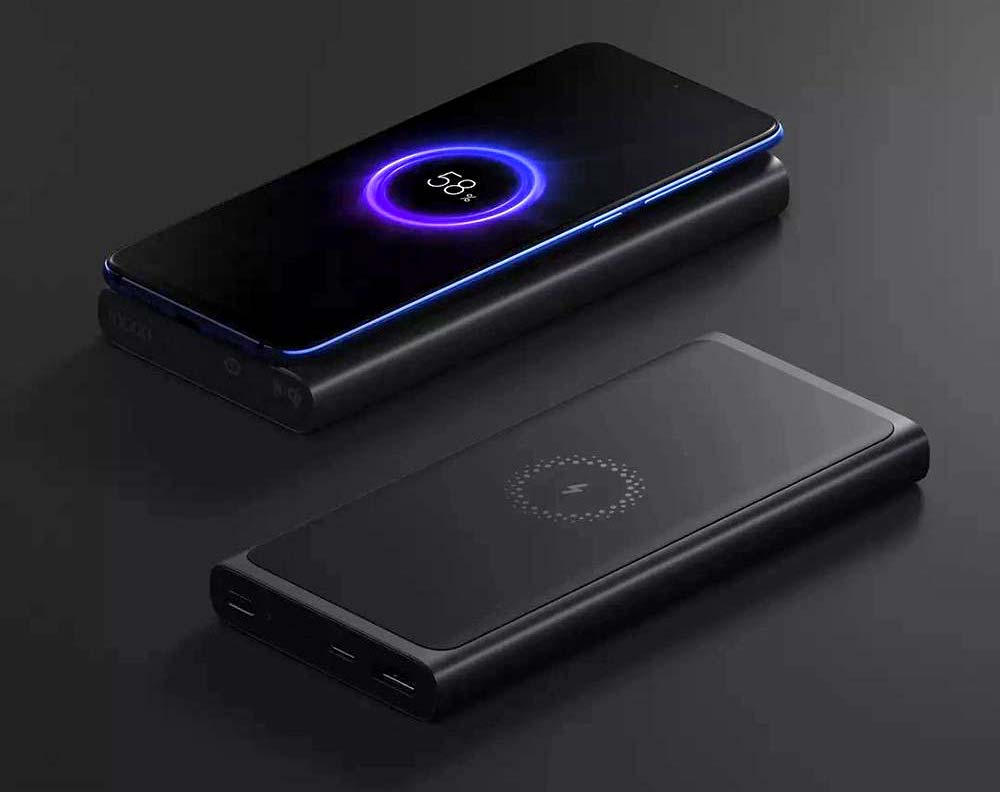
Samsung P1100 Powerbank - 10 mAh
Power bank capacity 10 000 mAh, with two charging sockets. When charging from one socket, it is able to generate charging current to 2A. When charging from 2 sockets, the approximate charging current is 1,2 - 1,7 A. Supports 2.0 Quick Charge technology. Has a charge indicator.
Check current powerbank price - [click]
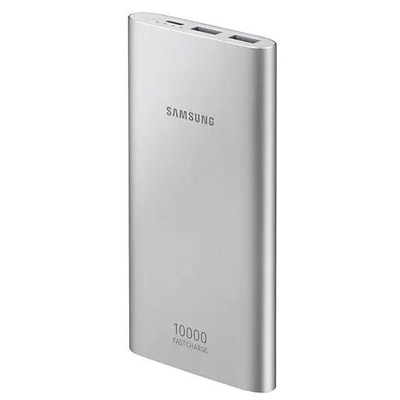
Xiaomi Mi 2s Power Bank - 10mAh
10 capacity 000 mAh and two charging sockets. When charging from two sockets, each is able to output 2,4A at 5V (!!!). Has a charge indicator.
Check current powerbank price - [click]
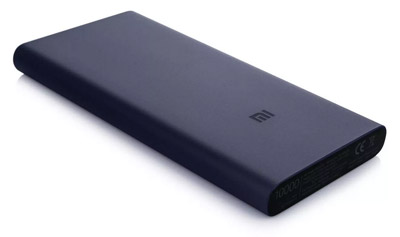
Powerbank Xiaomi 2C - 20 000mAh
A real monster with a capacity of 20 000 mAh. It is able to fully charge even a MacBook. When charging one device at 5V, it is able to charge with 3,6A. Charging two devices at the same time can be done with 2,4A current for each socket (of course at 5V). Supports Quick Charge 3.0 super fast charging technology. Of course, it has a charge level indicator.
Check current powerbank price - [click]
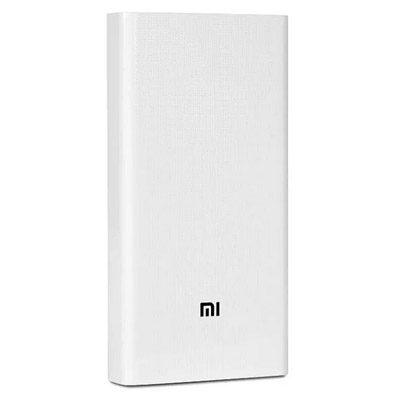
Sunen Powerneed Power Bank - 8mAh
Solar powerbank with a capacity of 8 000 mAh. This is the only device with a solar panel that I place in this statement, although I do it very reluctantly. As an energy bank, it is significantly inferior to those listed above, and from the solar panel it would take several dozen days to fully charge the power bank. In practice, the solar panel can, at most, maintain the current state of charge of the device. It has two charging sockets. Charging current 2A (voltage 5V) on the first socket, and 1 A (5V) on the second. It has a charge indicator and a solar radiation indicator informing if solar energy is sufficient to charge the power bank.
Check current powerbank price - [click]
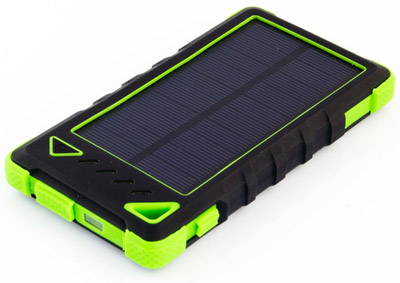
Is charging a solar power bank fictitious?
This is not fiction. This can be done effectively, but a slightly different solution must be used. The problem lies in the power of the solar panel, from which the powerbank will be charged. The solar panel with the side wall of the powerbank is simply too small (it has too small area). With the current efficiency of photovoltaic panels, a much larger surface area is needed for efficient charging.
Approaching the matter from the side of calculations, step by step the matter looks like this:
1. Powerbank charging time
To start with, you need to specify the time at which the powerbank should charge to 100% capacity, in other words the real time of access to strong sunlight. Let's assume that we will be able to expose the panel to the sun for 8 hours a day and the power bank should charge to 100% of capacity during this time.
2. Powerbank capacity
The charging time and capacity of the power bank are two basic parameters from which we will calculate the rest. Let's assume the capacity that I calculated earlier as appropriate for my needs: 10 000 mAh.
3. Powerbank charging current
From the above assumptions, we can calculate the minimum current that the powerbank should be charged to meet our expectations. We assume that charging is done with 80% efficiency.
10 000 / (8 * 0,8) = 1,6 A.
The minimum charging current that should be provided by the solar panel is 1,6 A.
4. Solar panel power
In the case of photovoltaic panels, however, the most common is not electricity but power (in watts). It is said: a panel with power ... and here the value in watts falls. We know that the standard operating voltage level (charging / discharging) of the power bank is 5V. From here, we can easily calculate the minimum power of the panel needed for our needs:
1,6 * 5 = 8 W
To fully recharge 8 solar hours with 10 000 mAh power bank, we will need a panel with at least 8W (watts).
The above calculation scheme can now be easily applied to your needs by substituting the values you are interested in in the right places.
I know the power of the panel and what's next?
Next you need to go on a search in the depths of the internet. Of course, we are looking for a panel with a capacity of about 8W and a voltage of about 5V. After a short time you will realize that there is quite a large selection of different, interesting solutions. Examples are provided below:
Backpack with solar panel SUNEN SBS 10
The panel power is 7W, with output voltage 5V. It almost perfectly fits our needs. The advantage of the solution is that the power bank can lie politely in a backpack connected by a USB cable to the panel, and we, for example, walk carefree in the mountains and charge the energy bank. Interesting solution.
Price: check the current price and availability of the backpack - [click]
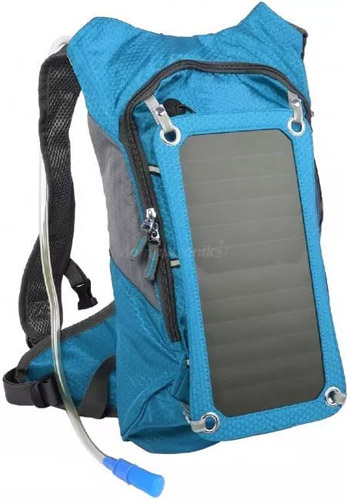
Photovoltaic panel in the form of a roll-up mat
The panel power is 9W and the voltage is 5V. It fits our needs perfectly. This solution is more suitable e.g. for a tent or camping. It would be much harder to walk with him. After rolling it has a rectangular shape of about 10 x 15 cm.
Price: check the current price and availability of the 9W panel - [click]
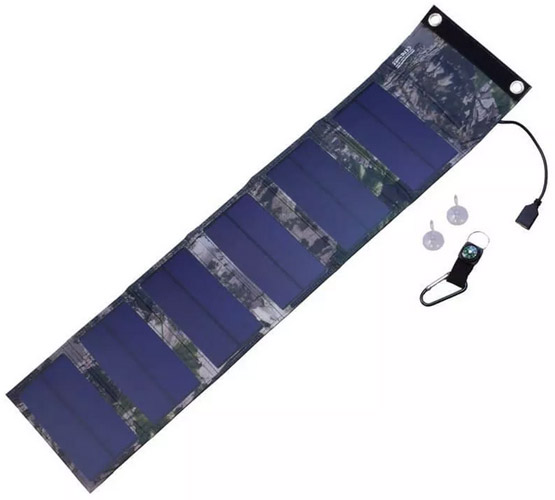
There is also a version of the expandable panel with the power of 6W and 18W.
There are other suggestions in the form of small fold-out screens, sheets, etc.
Below is a link to the list of proposed solutions related to obtaining energy from the sun.
see: Photovoltaic panels for various tasks - [click]
Not all of them fit our needs, but some of them are interesting and worth a look. The list at the above link groups proposals from different thematic categories, because solar solutions are found in various departments: from sports and clothing, to home and garden ... There is no single department in which they would be grouped according to our needs.
Click, browse, search! Some of these solutions are inspirational.
The equipment I use can be seen in a separate entry: Camera, camcorder, powerbank and other equipment that I use when traveling.
If you are wondering whether a smartphone is suitable as a camera for taking photos from holidays, read: A phone with a good camera? What smartphone for photos? We choose the best phone for photography!.
Important to me!
Give the article a good rating (5 stars welcome 😀)!It's free, a for me it is very important! The blog lives on visits and thus has a chance to develop. Please do it and ... thank you in advance!
If you like my guides, you will certainly find the one I created useful guide catalog - [click]. There you will find ready-made ideas for your next trips, descriptions of other tourist destinations and an alphabetical list of guides divided into countries, cities, islands and geographical regions.
I also post link to Facebook profile - [click]. Come in and press "Follow"then you will not miss new, inspiring posts.
Unless you prefer Instagram. I'm not a social media demon, but you can always count on something nice to look at on my instagram profile - [click]. The profile will gladly accept any follower who likes it.
I make the content I create available free of charge with copyright, and the blog survives from advertising and affiliate cooperation. So, automatic ads will be displayed in the content of the articles, and some links are affiliate links. This has no effect on the final price of the service or product, but I may earn a commission for displaying ads or following certain links. I only recommend services and products that I find good and helpful. Since the beginning of the blog's existence, I have not published any sponsored article.
Some of the readers who found the information here very helpful, sometimes ask me how you can support the blog? I do not run fundraisers or support programs (type: patronite, zrzutka or "buy coffee"). The best way is to use links. It costs you nothing, and support for the blog is self-generating.
Pozdrawiam

https://allegro.pl/oferta/energia-sloneczna-powerbank-outxe-ip67-10000mah-8501091809
Mega recommend, worth the money:>
Very good guide for those who are economical and for those who didn't have physics at school.
I'm glad he came in handy
Beautiful article, explained everything. Thanks:)
Today I was supposed to order on the Powerbank allegro at an encouraging low price in return for what it offers. I think, I will check the advice if I chose well. I found this blog. I am very glad that I came here - I know much more now and I will follow this knowledge when choosing the right equipment for me. Thank you and I recommend it to everyone.
A very interesting article, useful and detailed information, it is worth reading before shopping
Hello, I have a problem with the choice of a powerbank, I want something reasonably shockproof and partially waterproof / dustproof (IP65 would be ideal), but sellers rarely provide such parameters. Is there any model you could recommend? Capacity within 10k mAh.
As for me, the usual one is the best. The solar panel will be ok for some long trips with a backpack and a tent. As for wireless, I do not trust somehow. I have been traveling for 2 years with this equipment https://hamamobile.pl/power-pack-supreme-5hd-4 and it works perfectly, although recently I was thinking about buying something stronger
Thank you - very useful information.
Very useful information helped me choose!
I am in great shock that there is such a thing as a solar power bank. I am glad that producers are trying to focus on ecology. I liked how you presented the whole issue. It will definitely make the final choice easier for me.
Very helpful information. Thank you very much
Congratulations on your professionalism and, at the same time, on the clarity of the issue presented.
Great education. I benefited a lot. Understandably and substantively, you explained it. Thank you very much and I am going to read your blog about other equipment. :)))